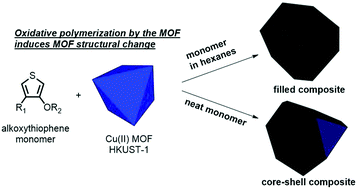Etching and polymerization reactions of alkoxythiophenes in HKUST-1: choosing between filled and core–shell MOF/polymer composite structures†
Abstract
In an earlier report, our group found that neat 3,4-ethylenedioxythiophene (EDOT) directly reacts with the Cu-based MOF HKUST-1 to form a core–shell composite in which the HKUST-1 surface is coated with conjugated polymer, while unsubstituted thiophenes formed a filled composite where polythiophene is contained in the MOF's pores. In this work, we found that EDOT and 3-methoxythiophene (3MOT), which react in the neat form to form core–shell composites, can be loaded into HKUST-1 pores without reaction when dissolved in hexanes. To a lesser extent, 3-hexyloxythiophene (3HOT) can be loaded in the same way. These hexane-loaded composites can then be heated, resulting in the formation of a ‘filled’ composite. This finding allows us to choose to prepare either a core–shell or a filled composite by selecting reaction conditions. The process of heating with alkoxythiophenes results in a morphology change in the HKUST-1 material, at a surprisingly low temperature. Composites were characterized by nitrogen sorption measurements, powder X-ray diffraction, and vibrational spectroscopy.

- This article is part of the themed collection: Coordination Networks


 Please wait while we load your content...
Please wait while we load your content...